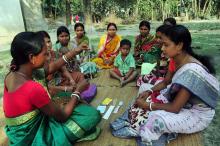
Currently, approximately 214 million women of reproductive age in low- and middle-income countries want to avoid pregnancy, yet are not using a modern contraceptive method. Additionally, within the next decade, a record number of adolescents in the low-resource regions will enter their reproductive years. In the future, as in the past, family planning (FP) will help save the lives of countless women and children, and will help alleviate poverty, reduce stress on the environment, and ensure that families are better able to feed, clothe, and educate their children.
This course provides an overview of the basic information relevant to FP programs and services, including rationale for voluntary FP, contraceptive method considerations, contraceptive options (including short-acting, long-acting, and permanent methods), and FP for clients with special needs. It also addresses quality of services and access to care, as well as contraceptive security. Finally, the course highlights key tools to facilitate service delivery, client counseling, and provider training.
Objective
By the end of the course, learners will be able to:
- Describe the benefits of FP
- Define unmet need for FP
- Discuss the importance of voluntary choice in FP programs and services
- Describe key attributes of FP methods
- Describe the FP guidance provided by the World Health Organization (WHO)
- Describe the most common short-acting methods of FP
- Describe the most common long-acting and permanent methods of FP
- Describe FP considerations unique to the client with HIV, the postpartum client, the postabortion care (PAC) client, and the client who needs emergency contraception
- Discuss quality of, and access to, FP services
- Describe several key FP service delivery tools
- Discuss key elements of contraceptive security
Credits
The following individuals are greatly appreciated for their support and expertise in the revision of this course (2018):
Margaret D'Adamo, Kelsey Bilek, and Anita Dam of USAID.
The following individuals provided invaluable support for the development of the first version of this course (published Oct 1, 2007):
- Holly Blanchard, ACNM/ACCESS-FP
- Douglas Huber, Management Sciences for Health
- Patricia MacDonald, USAID
- Judy Manning, USAID
- Catherine McKaig, Jhpiego/ACCESS-FP
- Kevin Pilz, USAID
- Roberto Rivera, Independent Consultant
- Lois Schafer, USAID
- Patricia Stephenson, USAID
Time
- 2 hours 30 minutes
Published/Updated
- Wednesday, October 10, 2018
Course Authors:
Updated by: Irina Yacobson, FHI 360 (2018)
Developed by: Barbara Deller and Jim Shelton (2007)
Course Managers:
- Amy Lee, CCP
Related Courses
- Community-Based Family Planning
- Family Planning Counseling
- Family Planning and HIV Service Integration
- Healthy Timing and Spacing of Pregnancy (HTSP)
- Postpartum Family Planning
